The implementation of an agreement between Iran and Azerbaijan to swap the Turkmen gas is set to strengthen the Islamic Republic’s role in the energy equations of the Caspian region. The swap deal which went into effect on Saturday marked the first step in efforts that began 25 years ago to turn Iran into the center of gravity and a gas hub in the region, Narsi Ghorban told the ministry of petroleum’s Shana news agency. “Iran, due to its geographical location, can receive gas from producing countries and deliver it to the countries that have gas shortages on the other side of the border. With this, Iran will turn into a major gas transmission conduit in the region,” he said.
Iran is currently exporting gas to Turkey and Iraq, but other opportunities such as exports to Pakistan and India have not been utilized yet, PressTV writes.
For the Turkmen gas swap, Iran is using the pipeline which it used to import gas for consumption in its northern provinces. “If we want to increase the volume of the contract, we have to build more pipelines in the country,” Ghorban said.
Iran’s gas reserves are the second largest in the world after Russia’s and amount to about 16 percent of all world reserves. However, Russia has many pipelines for gas exports, and “if Iran wants to achieve a prime position in global gas transactions, it must strengthen its infrastructure in terms of gas production and transmission, and put consumption optimization on its agenda”, Ghorban says.
Iran, Turkmenistan and Azerbaijan signed the gas swap deal on the sidelines of the 15th Summit of the Economic Cooperation Organization (ECO) in Ashgabat on Dec. 28. Under the swap deal, Iran will receive up to two billion cubic meters of gas from Turkmenistan and deliver an equivalent amount to Azerbaijan at the Astara border. Turkmenistan will sell 5-6 million cubic meters of gas per day to Azerbaijan under the trilateral agreement.
Iran has major natural gas fields in the south, but has imported gas from Turkmenistan since 1997 for distribution in its northern provinces, especially during the winter. “By signing this agreement, a step forward was taken in the energy relations between the two countries, which will also help provide sustainable fuel for Khorasan Razavi, North and South Khorasan as well as Golestan and Semnan provinces in the winter,” Minister of Petroleum Javad Owji said in the Turkmen capital.
Why is it a big deal?
The gas swap deal – although not large, but an important step from the perspective of energy experts - is the first achievement of Owji’s ministry which has put activation of energy diplomacy and development of Iran’s cooperation with neighboring countries on the agenda since assuming office in August.
Many experts agree that even with 100% domestic gas supply, gas imports from Turkmenistan should not be cut off, because the gas received from the country is cheap. The trade allows Iran to consume the imported gas in the country’s north and export an equivalent amount at a higher price to neighboring countries.
They believe each of Iran’s neighbors has advantages that should be taken into account in its international relations, especially with Turkmenistan which is a strategic neighbor. Owji said in Ashgabat that Iran was moving to resolve the lingering gas debt dispute with Turkmenistan, which claimed in late 2017 that it was owed $1.8 billion in payments for gas delivered to Tehran. “We will soon pay the first installment to clear the gas debt that we owe to the Turkmen side, after talks that were held earlier,” Owji said, without giving the amount of the debt.
According to former deputy petroleum minister Mansour Moazzami, restoring economic relations with Turkmenistan is an important step. “Turkmenistan is a neighbor of Iran, and by concluding the gas contract, we have strengthened our relations with Turkmenistan. This is definitely in our country’s interest,” he told Fars news agency. “In fact, my ideal is for Iran to buy all of Turkmenistan’s gas for exports and given its privileged geopolitical position, export it to other countries.”
Senior energy expert Gholamhossein Hassantash says using Iran’s vast area for swaps, transit and facilitating transportation of neighboring countries is an economically positive move that will help strengthen political relations and reduce regional tensions. “Such agreements are in the interests of both foreign policy and the energy sector,” he said.
More importantly, the gas swap agreement has been implemented under a grand strategic plan to dismantle the US strategy against Iran in the regional gas market. In other words, with the conclusion of this agreement, the regional gas market equations have changed and the threat of the Trans-Caspian and TAPI pipelines to the Iranian gas market has been removed. Turkmenistan’s leader has ordered construction of a $10 billion pipeline to Pakistan and India through Afghanistan to begin despite questions about the project, the Turkmen government says. The Trans-Caspian Gas Pipeline is planned to transport Turkmen and Kazakh gas to the European Union through Azerbaijan. The TAPI pipeline aims to transport gas along a 1,800 km route from Turkmenistan to India via Afghanistan and Pakistan. Both projects and other schemes have been conceived with the US idea of bypassing most viable Iranian routes.
“In fairness, the logic of the gas swap agreement between Turkmenistan and Azerbaijan is very precise. The issue is not just the supply or non-supply of gas to the five northern provinces of Iran; Iran has also found a positive window for cooperation on the Lapis Lazuli corridor - something that seemed very unlikely until two months ago,” economic expert Majid Shakeri told Fars news agency, referring to an international transit route that opened in 2018 linking Afghanistan to Turkey via Turkmenistan, Azerbaijan and Georgia.






